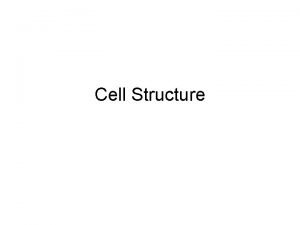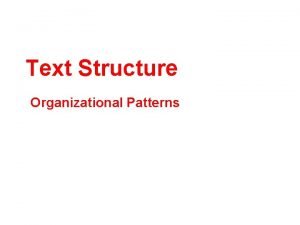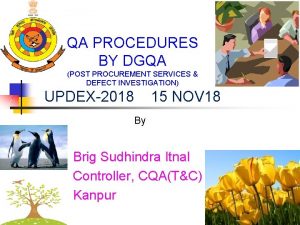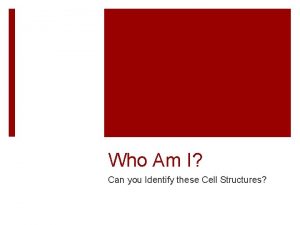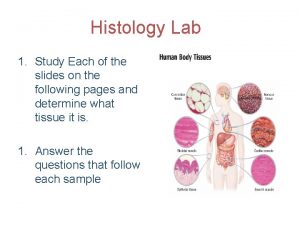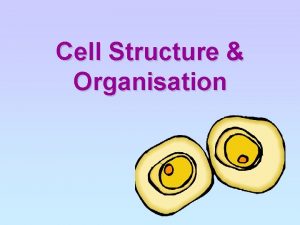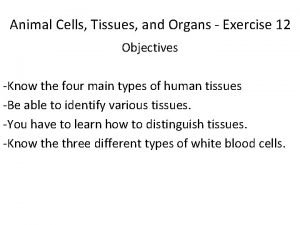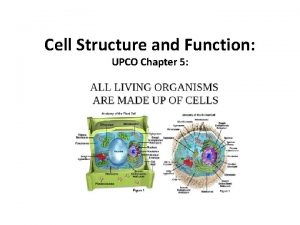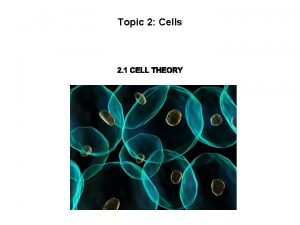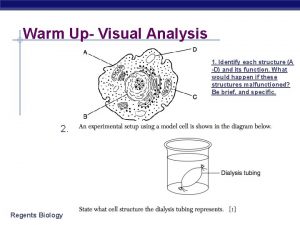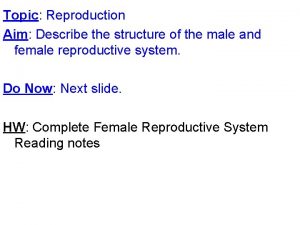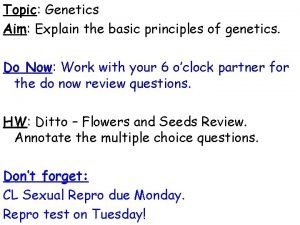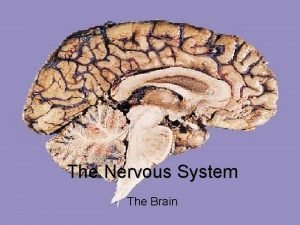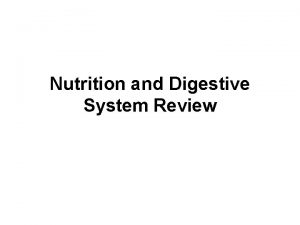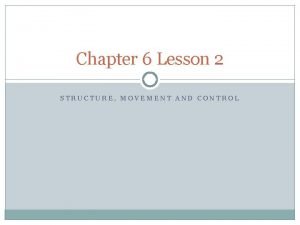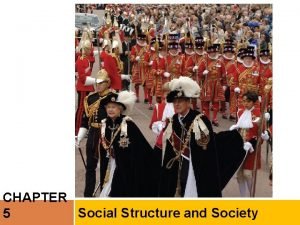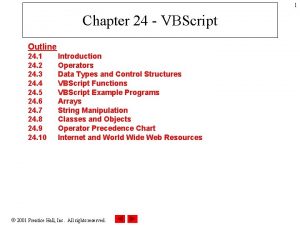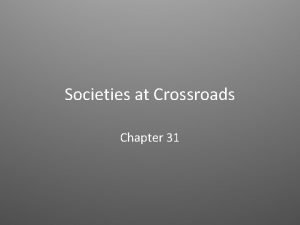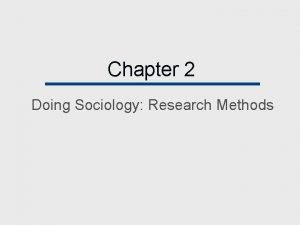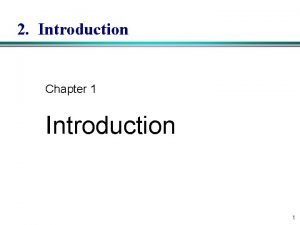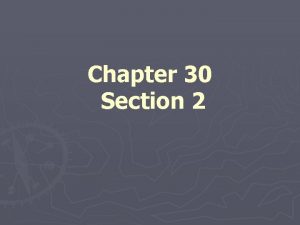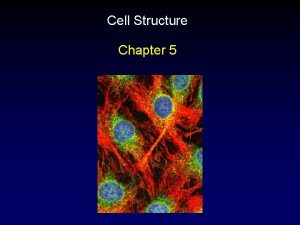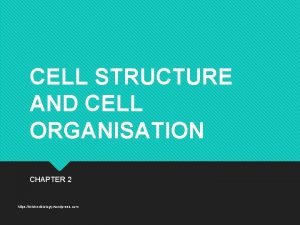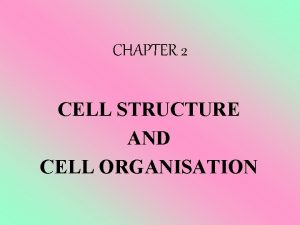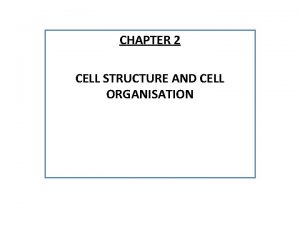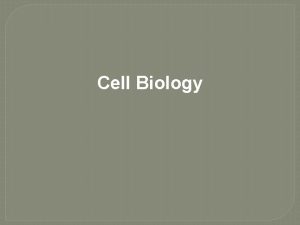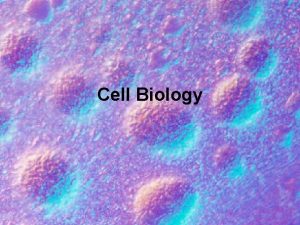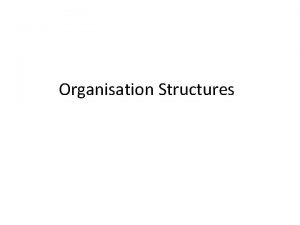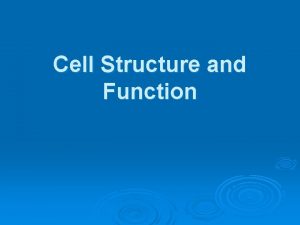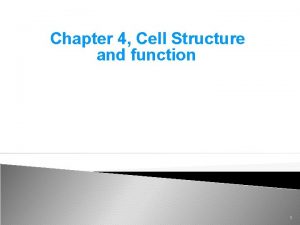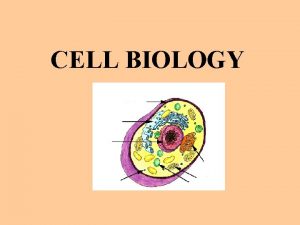Cell Structure Organisation Chapter Outline a identify cell














































- Slides: 46

Cell Structure & Organisation

Chapter Outline (a) identify cell structures (including organelles) of typical plant and animal cells from diagrams, photomicrographs and as seen under the light microscope using prepared slides and fresh material treated with an appropriate temporary staining technique: • chloroplasts • cell membrane • cell wall • cytoplasm • cell vacuoles • nucleus

Chapter Outline (b) identify the following organelles from diagrams and electronmicrographs: • mitochondria • ribosomes (c) state the functions of the organelles identified above (d) compare the structure of typical animal and plant cells

Chapter Outline (e) state, in simple terms, the relationship between cell function and cell structure for the following: • absorption – root hair cells • conduction and support – xylem vessels • transport of oxygen – red blood cells (f) differentiate cell, tissue, organ and organ system

What is a cell? • Building blocks of life • Simplest units of life • Chemical reactions in the cell keeps us alive

Cells Red Blood Cells White Blood Cells

Cells Embryonic Stem Cells

Other Examples of Cells Amoeba Proteus Plant Stem Bacteria Red Blood Cell Nerve Cell

Cells What does a cell consists of? Each living cell consists of living material called protoplasm. Protoplasm: • Water makes up 70% of protoplasm • Proteins • Carbohydrates • Fats

Protoplasm 1) Cell Surface Membrane 2) Cytoplasm 3) Nucleus

Cell Structures in Plant and Animal Cells • nucleus • cytoplasm • cell membrane • cell wall • cell vacuoles • ribosomes • mitochondria • chloroplasts

Animal and Plant Cells Animal Cell Plant Cell Structure and Function: http: //lgfl. skoool. co. uk/keystage 3. aspx? id=63

Animal Cell

Animal Cell

Cell Surface Membrane • Surrounds the cytoplasm of the cell • Partially permeable membrane – Allows some substances but not all to move in and out of the cell

Nucleus • Surrounded by a membrane called the nuclear envelope • Contains one or more nucleoli • Contains chromatin Functions of the nucleus: 1. as 2. Controls cell activities such cell growth and the repair of worn-out parts Essential for cell division Nucleolus

Cytoplasm • Between the cell surface membrane and the nucleus • Contains enzymes and organelles

Organelles in the Cytoplasm • • Mitochondria Ribosomes Chloroplasts (only in plant cells) Cell vacuoles

Mitochondria • Aerobic respiration occurs in the mitochondria • Energy production • Energy used to perform cell activities such as growth and reproduction

Ribosomes • Required for protein synthesis in the cell

Vacuoles in Animal Cells • A vacuole is a fluid-filled space enclosed by a membrane • Animal cells have many small vacuoles that contain water and food substances such as proteins and carbohydrates

Pop Quiz! Label and identify the diagram D E A B F C

Plant Cells: http: //lgfl. skoool. co. uk/keystage 3. aspx? id=63

Plant Cell

Differences Between Animal and Plant Cells Animal Cells Plant Cells Cell wall absent Cell wall present Chloroplasts absent Chloroplasts present Vacuoles are small, temporary in animal cells Vacuoles are large, sapfilled in plant cells

Cell Wall • Surrounds the cell surface membrane • Cell wall is made of cellulose • Protects the cell from injury • Gives the plant cell a fixed shape • Cell wall is fully permeable

Chloroplasts • Found only in plant cells • Chloroplasts contain a green pigment called chlorophyll • Chlorophyll is essential for photosynthesis, the process by which plants make food

Vacuoles in Plant Cells • Plant cells usually have a large central vacuole which contains a liquid called cell sap • Cell sap contains dissolved substances such as sugars, mineral salts and amino acids

Pop Quiz! Label and identify the diagram A D B E C F


Specialised Cells Red Blood Cell Sperm Cell Nerve Cell Root Hair Cell Egg Cell

Cell Differentiation The process by which cells develop special structures or lose certain structures to enable them to carry out specific functions. Hence, cells become differentiated to form specialised cells. The structure of each cell is adapted to perform the specific functions of the cell.

Cell Differentiation

How is cell structure related to cell function? 1) Red Blood Cell Structure Contains haemoglobin No nucleus Adaptation to Function Haemoglobin transports oxygen from the lungs to all parts of the body. Carry more haemoglobin which leads to increased transport of oxygen. Circular biconcave shape Increased surface area to volume ratio of the cell. Hence, increased transport of oxygen.

How is cell structure related to cell function? 2) Xylem Vessel Cell Structure Adaptation to Function Long hollow tubes (no protoplasm) Enables water to move easily through the lumen. Lignified walls Lignin strengthens the walls and prevents the xylem vessels from collapsing.

How is cell structure related to cell function? 3) Root Hair Cell Structure Long and narrow Adaptation to Function Increased surface area to volume ratio of the cell which leads to increased absorption of water and mineral salts from the soil. Specialised Plant and Animal Cells: http: //lgfl. skoool. co. uk/keystage 3. aspx? id=63

How do cells work together in a multi-cellular organism? Organisation in Living Things: http: //lgfl. skoool. co. uk/keystage 3. aspx? id=63

Tissue A tissue is a group of similar cells which work together to perform a specific function. Examples of tissues: • Muscle, the lining of the intestine, the lining of the lungs, phloem, root hair tissue Connective Tissue

Organ Different tissues may be combined together to form organs. An organ is a structure made up of different tissues working together to perform a specific function. Examples of organs: • Heart, lung, brain, leaf, root Lungs

An organ is a structure made up of different tissues working together to perform a specific function.

Organ System Organs work together to form organ systems. Various systems work together to make up the entire organism. Examples of organ systems: • Circulatory system, respiratory system, digestive system, nervous system and reproductive system Circulatory System

Organ Systems

Organs work together to form organ systems. System Organs Digestive Esophagus Stomach Small intestine Large intestine Trachea Lungs Respiratory

Pop Quiz! Q 1. Write out the order of cell organisation within an organism. Q 2. Give an example of an animal system with the order of cell organisation stated above.

Pop Quiz! Q 1. Write out the order of cell organisation within an organism. Organism

Pop Quiz! Q 2. Give an example of an animal system with the order of cell organisation stated above. • Intestinal cell intestinal muscle small intestine digestive system human • Nerve cell nerve tissue eye sensory system bird
 Eukaryotic cell organisation
Eukaryotic cell organisation Project organisation structure
Project organisation structure Text structure spatial
Text structure spatial School management organogram
School management organogram Ecommerce organization chart
Ecommerce organization chart Dgqa organisation structure
Dgqa organisation structure Quotation sandwich
Quotation sandwich The scientist mathias schleiden studied _______ in ______.
The scientist mathias schleiden studied _______ in ______. Im strong and stiff getting through me is tough
Im strong and stiff getting through me is tough Identify
Identify Predominant cell type
Predominant cell type Root hair cells
Root hair cells Identify the cell
Identify the cell Biology chapter 7 cell structure and function
Biology chapter 7 cell structure and function Chapter 7 cell structure and function section review 7-2
Chapter 7 cell structure and function section review 7-2 Chapter 5 cell structure and function
Chapter 5 cell structure and function Plant cell animal cell venn diagram
Plant cell animal cell venn diagram Outline one therapeutic use of stem cells
Outline one therapeutic use of stem cells Identify the structure
Identify the structure Chronological signal words
Chronological signal words What is cause and effect text structure
What is cause and effect text structure Spatial text structure
Spatial text structure Identify the text structure of the following passage
Identify the text structure of the following passage Identify the structure
Identify the structure Cowper's gland
Cowper's gland Are blue eyes dominant or recessive
Are blue eyes dominant or recessive Reticular activating system
Reticular activating system Structure of the stomach labeled
Structure of the stomach labeled Structure movement and control answer key
Structure movement and control answer key Body paragraph layout
Body paragraph layout Social statuses
Social statuses Unorganized points and outline structure
Unorganized points and outline structure 3 market need
3 market need Labeling theory of deviance examples
Labeling theory of deviance examples Romans outline by chapter
Romans outline by chapter Work plan for research proposal
Work plan for research proposal Give me liberty chapter 27
Give me liberty chapter 27 Secondary data
Secondary data Chapter 38 a world without borders outline
Chapter 38 a world without borders outline Vbscript
Vbscript How did rue die hunger games
How did rue die hunger games Chapter 31 societies at crossroads
Chapter 31 societies at crossroads Ap world history chapter 28 outline
Ap world history chapter 28 outline Advantages and disadvantages of observation method
Advantages and disadvantages of observation method Chapter 1 outline
Chapter 1 outline Chapter 1 outline
Chapter 1 outline Chapter 30 section 5 outline map the vietnam war
Chapter 30 section 5 outline map the vietnam war
